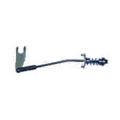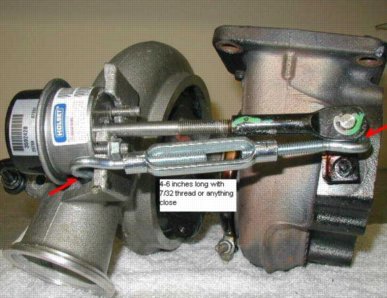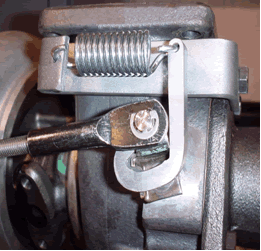The simple explanation: a waste gate limits the maximum boost generated by the turbocharger.
How it works and what it does:
The waste gate uses a pressure activated diaphragm and rod to operate an exhaust bypass around the turbocharger and thus limit the maximum boost that the turbocharger can produce. This permits an engine manufacturer to use a "fast" turbo charger with a small exhaust housing to produce useable boost at low engine speed and load. To prevent excessive boost at higher engine speeds, the waste gate limits the maximum boost to a safe level for the engine, and prevents turbocharger over-speed.
The factory uses a small exhaust housing so that boost can be built very quickly, like small tube headers induce exhaust flow faster. However, the turbo could over speed and/or the exhaust restriction from small exhaust housing ports could choke the flow and horsepower at higher rpm. Therefore, a waste gate is used. A hole, about 1" diameter, is drilled into the side of the rear exhaust housing port. A flap valve connects this hole to a bypass port leading directly to the exhaust pipe. Therefore, when the waste gate opens, some of the exhaust flow is bypassed from the turbine fins. This waste gate helps to limit total boost, because it opens at a preset amount of boost. Enough gas is bled off so that boost effectively is limited to that value (18-23 lb for most B engines). The higher rpm hp is still choked by the small housing ports, but for emission purposes, it is more important to build some boost very quickly so that fuel can be allowed without smoke.
The waste gate operation is simple. A pressure line goes from either the compressor housing (e.g. the 180 hp engine) or from the intake manifold (via a T fitting on the AFC housing on top of the injection pump governor) over to a pressure motor attached to the turbo exhaust housing. The waste gate flap is held closed by the heavy spring in the pressure motor, through a linkage. When boost pressure to the pressure motor overcomes the heavy spring, the linkage opens the waste gate flap
MOD IT ??
Turning up the waste gate will increase the air volume that is stuffed into the cylinder. This *may* reduce the EGT, but will not increase power. How do you get more power? One way: more fuel = more power. To increase the power, the fuel rate must be increased. The boost should only be increased to match the fuel curve for smoke and EGT control. Several tests have been done where a truck was run on a dynamometer, the boost was increased by blocking the waste gate signal, and the truck was re-tested on the Dyno. In every case reported, no power increase was measured.
The 12 Valve engines do not have a problem with excessive boost.For improved performance on pre 94 engines, a 16 sq cm turbine housing is usually the best compromise between low speed boost and high speed exhaust restriction. The stock 12 cm housing on 94+ engines is OK up to about 240 HP, beyond which the small housing restricts the exhaust and raises EGT. A 16 cm housing provides enough low speed boost for an enhanced engine, and the exhaust runs cooler at high speed.
The engine computer on ISB engines is designed to prevent excessive torque from causing damage to the drivetrain, and monitors the boost for "excessive" power. The computer will reduce the fuel rate it will cut back the throttle – when the boost exceeds 21 psi on 215hp and 235hp engines With out a boost fooler which is included in performance boxes.
BLAH BLAH BLAH……. OK HERE YOU GO !!!!!!
HOW TO MOD IT ….
If you do not have a hard lined waste gate just cut the hose and shove a bolt down it to plug it or … install Turbo-Master MODEL 24 Boost Control

If your WG is hard lined there are a few options:

Turn Buckle (Available at a hardware store — Found mine at TSC).

Another Option

J- Hook

